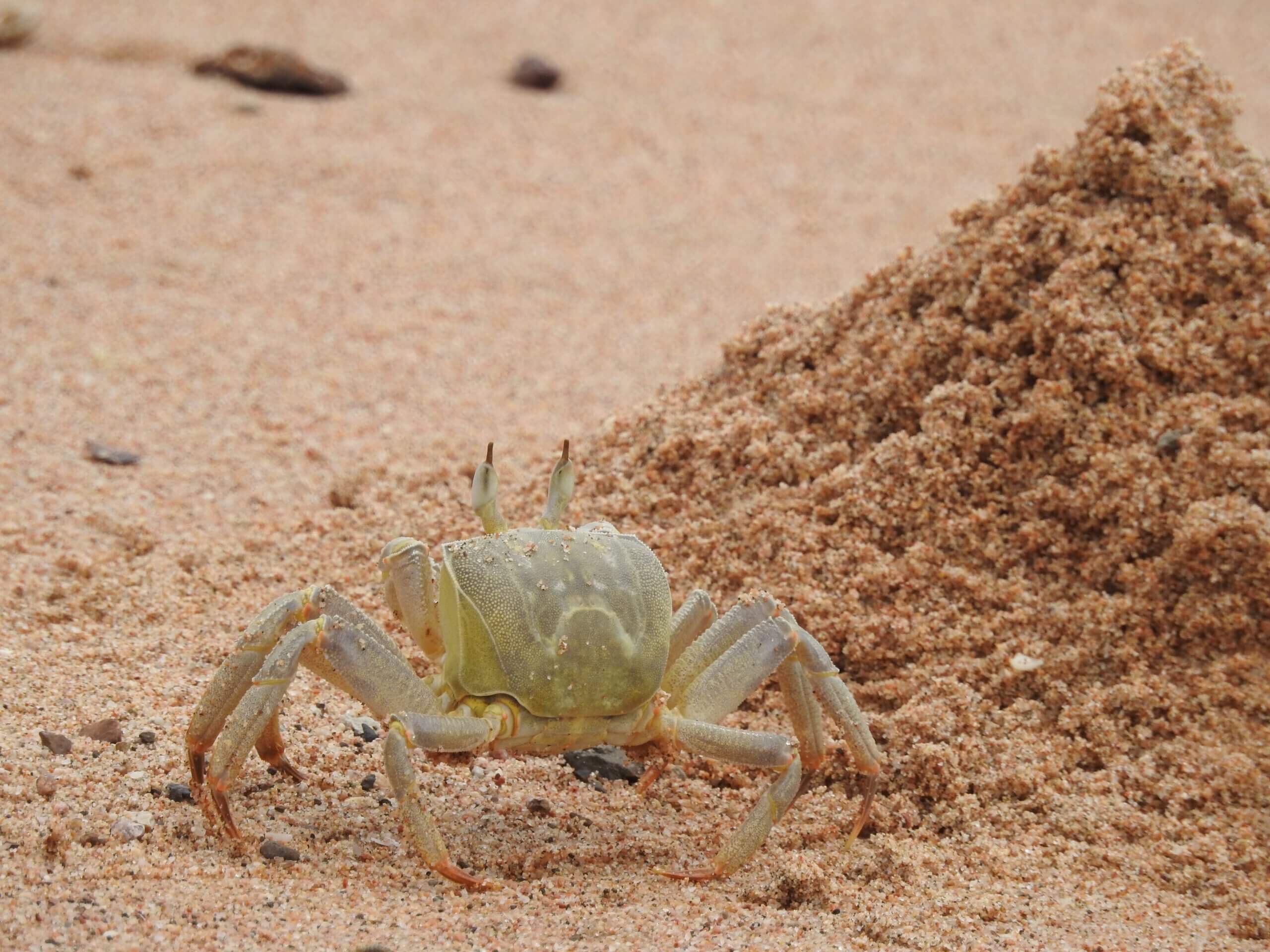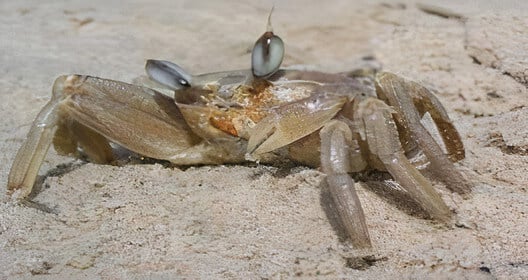חAnd the Red Sea loon, a small crab that used to be common in the Gulf of Eilat, is in serious danger due to the development of tourism and beach bathing. A new study, in which students and students in the city took part, reveals the damage to the living fabric of crabs alongside humans and suggests ways to protect them
By Sahar Yitzhak, Angle - Science and Environment News Agency

The stretch of beach in the Gulf of Eilat is dense and small, but over the years it has become the scene of major environmental struggles. The struggle to remove Eilat's fish cages, which according to a recently published study, They still pollute even many years after they are taken out of the sea, was one of the best sellers in the first decade of the 21st century. currently, The fight that is being waged for the cancellation of the KTAA agreement for the transportation of oil from the Emirates, aims to sweep away many Israelis who are afraid of the environmental consequences that could harm the Bay of Eilat, the ecosystems on the shores of the Mediterranean and the drinking water supply of the State of Israel, 80% of which is produced by desalination of seawater.
Another environmental struggle, much more modest but also important, deals with the fate of a small marine animal: the "Holon Yam-Sof", a crab that is found in the Gulf of Eilat and is facing existential danger. This struggle is led by Prof. Reuven Yosef, a researcher and lecturer from the Eilat campus of Ben Gurion University of the Negev and a teacher at Rabin High School for the Sciences. Together with his pupils and students, Yosef manages at the same time A study on the population of Red Sea Holoni on the north coast in Eilat and a campaign to increase awareness of the damage caused by tourism in the area to these small crabs and other animals in the bay.
The Red Sea crayfish is an endemic cancer (unique and limited in distribution) to the shores of the Red Sea. In the past, it was common throughout the northern coast of Eilat, but today its habitat is much more limited. "Over the years, and in a controversial decision, it was decided to fill the beaches with gravel soil originally from the area's wadis," Yosef explains the origins of this environmental problem, "this is the sand we know today on the beaches of Eilat, but it arrived in an unnatural way to make vacationers enjoy their time at the beach ... Thus, in fact, they completely changed the habitat that had been created for many years in one move and the holon simply could no longer live in such a place."
The only refuge left for the crabs is a stretch of beach called "Aradag Beach" after the logistics complex of the companies that operated the fish cages in Eilat. The strip was then fenced off, without tourists, and its beach was not paved with gravel. Even after the fish cages were removed, when the beach was for bathers, the municipality did not add gravel and the beach remained sandy - which allowed the crabs to continue building their burrows and exist in the area.
Man versus the sick
"But even the small strip of beach was not safe for the crabs," says Yosef, "when they opened the beach to bathers, the encounter between the crab and the vacationers was fatal for the holons." Thus, for example, in the observations made by Yosef with his students, they saw vacationers hunting the crabs and cooking them on the fire.
The researchers also observed citizens destroying (either accidentally or maliciously) the crabs' homes - the burrows they build in the sand to stay in during the day and the tall sand pyramids the males build to impress females as part of their courtship displays.
Even when the bathers leave the beach after sunset, the crabs do not have peace and quiet, because during these hours there are trance parties on the beach that prevent the crabs from coming out of hiding to gather food or repair the damage caused to their burrows.
More crabs roam the beach
Not many scientific studies have been published on the Red Sea holoni, but soon the study conducted by Yosef with his students will be published, the main parts of which were presented inThe annual science and environment conference 2021. In one of the most important chapters of the research, the students compared the crab activity on the tourist beach and the nearby beach used by the navy. The findings were unequivocal: the number of burrows was similar, but on the tourist beach the crabs dug much more, for the reason that more burrows were destroyed. In addition, the number of pyramids on the Navy beach was seven times higher than the number of pyramids on the tourist beach. On this coast, the construction of pyramids was more common and the conclusion is that the crabs have to work much harder in building the burrows and pyramids when they live in the human environment.
Another interesting statistic shows that on the tourist beach the number of wandering crabs is much higher, because the vacationers destroy the burrows and the crabs have no choice but to wander on the beach.
What do you care about crabs?

As mentioned, alongside the scientific research, Yosef and his students also waged a public struggle for the crabs in the Gulf. "We came to the beach many times to explain the situation to vacationers and tried to raise their awareness as much as possible," says Shalu Edelman, a graduate of Rabin High School in Eilat, who was one of the leaders of the research and the struggle. "The reactions of the bathers at the beach were not always pleasant. When I warned the boy who damaged the crabs' burrows, for example, his father got angry with me and didn't understand why I even cared about them."
"The Red Sea window is very important as a factor in the environmental system that strengthens the hygiene of the beach", Yosef explains why it is important to protect the crabs. According to him, the Red Sea sea urchin acts as a sort of nature's sanitation worker, cleaning the beaches of organic matter, such as algae, dead jellyfish and other animal remains.
The next stop for Yosef and his disciples was the city council. "Ultimately, the municipality is responsible for enforcement, but the inspectors do not warn vacationers at all when they harm crabs," Yosef explains, "therefore, my students came to the education committee in the municipality to protest the intention Turn this stretch of beach into a 'Thai beach' - which is expected to include the introduction of unnatural sand into the area. Such an action could finally eliminate the crab population on Eilat's beaches."
"Through signage, information, awareness and enforcement, people will be able to bathe at the beach next to the crabs," says Yosef, "but the municipality must prohibit the entry of dogs and erecting tents, and limit the number of visitors to the beach." "You have to understand that we are talking about a very short stretch of beach of 200 meters, the tourists and the residents of Eilat have enough sea, you can give the crabs their place", Shalu concludes.
The Nature Authority and the Gardens describe a slightly different reality. According to them, on the beach open to the public, which is about 100 meters long, there are only a few crabs, if any, while on the closed beach, which is about 400 meters long, there is a relatively large population, which is occasionally damaged when the navy exercises on the beach. "The Holon crab population cannot exist on a public beach and it is important to concentrate efforts in the right places, especially when there is a severe plight of beaches open to the public in Eilat," says Dr. Assaf Zebuloni, an ecologist of the Gulf of Eilat at RTG. "We cannot prevent vacationers from walking on the beach if it is defined as a beach open to the public." Therefore, according to him, RTG is in contact with the Navy in order to prevent the damage to the crabs in the military area and also promotes the declaration of a coastal and marine nature reserve whose main goal is to protect the last population of the Sufi sea holon crabs in Israel.
Eilat Municipality's response:
"As a general rule, the municipality of Eilat works all the time to preserve and preserve the natural values with which the city of Eilat has been blessed. The municipality works to maintain a balance between the values of nature and the needs of tourism and development, therefore it is not possible to declare significant parts of the coastal strip as a nature reserve. However, very significant limitations are imposed on development so as not to damage natural values. The actions to protect the bay include the prohibition of lighting fires and placing tents (except in permitted areas), beach and marine cleaning operations, unique youth movements for the protection of the bay "Gulf Keepers" and "Ilteva".
"Regarding the northern coast, where private tents are allowed and not shelters or caravans just like on the southern coastal strip defined as a nature reserve, there is no detailed planning regarding the beach. Of course, whatever happens, it will be done with due consideration for the beach and the environment."
More of the topic in Hayadan:
